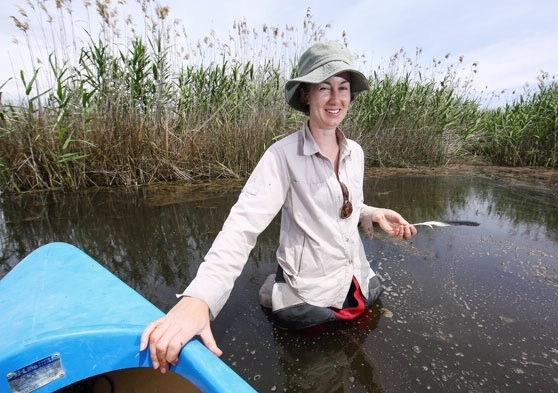Australians are being asked to collect wetland bird feathers to help scientists create the first ever ‘Feather Map of Australia’ to show the health of the country's wetland birds.
Wetland habitats are critical for Australia’s waterbirds, but they are under threat from reduced river flows and flooding, drought, climate change and land use changes.
In a joint research project between the Australian Nuclear Science and Technology Organisation (ANSTO) and UNSW, “citizen scientists” are being enlisted to gather bird feathers from wetlands.
Each bird feather is like a memory chip of where that bird has been.
The feathers will be analysed using nuclear techniques to understand the diet and environmental conditions that grew the feather.
Each bird feather is like a memory chip of where that bird has been. For example, a feather found in a wetland in NSW, once analysed using nuclear techniques, can reveal the bird has been living in the Northern Territory.
Scientists will compare feathers from diverse parts of Australia, to identify differences and create a map to understand more about these ecosystems.
“There are some big questions about waterbirds, which we are seeking to answer,” says project leader
Dr Kate Brandis, an environmental researcher and waterbird expert with UNSW and ANSTO.
“Colonies of birds come together in their thousands on flooded inland water systems to breed, then they disappear into much smaller groups and you might not see them for years.
“We would like to determine where they go, and where they come from, to find out which wetlands are really important for certain species,” says Dr Brandis.
The research team also includes Professor Richard Kingsford from UNSW’s Centre for Ecosystem Science and Dr Debashish Mazumder and Dr Suzanne Hollins from ANSTO.
“We are primarily interested in inland wetlands where you find birds such as colonial straw-necked and glossy ibis, as opposed to coastal estuarine wetlands,” says Dr Brandis.
“Wetlands around Australia are under threat from reduced river flows and flooding, drought, climate change and land use change.
“These are crucial habitats for Australia’s waterbirds, providing places for nesting, feeding and roosting, and if there are not flooded wetlands, the waterbirds don’t breed.
“We are also hoping to determine whether the birds return to the wetlands where they hatched, to breed – there is some debate as to whether this idea of a ‘natal site fidelity’ exists,” she says.
Information from the Feather Map will improve understanding of the ecology and life cycles of waterbirds and waterbird populations, and ensuring their populations are maintained or increased.
“Everyone can take part, from school groups to birdwatchers - anyone wanting to help preserve our precious wetland ecosystems,” says Dr Brandis.
“The more feathers, the more complete the picture and the better the map we will have.”
This unique project provides a non-invasive method to acquire samples, and also avoids welfare issues associated with tagging, tacking or capturing individual birds.
Wetlands are areas where water covers soil year round, or just some of the time – swamps, marshes, lakes, billabongs, lagoons, saltmarshes, mudflats, mangroves, dams and farm dams, rivers and creeks all classify.
HOW TO GET INVOLVED:
Step one: Understand the scientific licence or permit requirements for your state or territory.
The Feather Map of Australia Project has obtained licences from each state and territory in order for members of the public to help us with this important research. Each state or territory has their own strict rules and regulations – please check online for permit details relevant to you.
Step two: Visit a local wetland in your region and collect feathers that you find on the ground. Please leave any feathers attached to birds in place! Take a look around the wetland while you are there and write down any birds you recognise. Please ensure you wash your hands thoroughly after touching the feathers (or wear gloves while collecting).
We also encourage everyone to take lots of photos while collecting to add to our Instagram page feathermapau.
Step three: Place the feathers in an envelope including the following information:
- Date of collection
- Location of collection: preferably co-ordinate information (GPS location, latitude and longitude). This can be taken from smart phones or Google Maps)
- A list of the birds you identified using the wetland
- Type of bird feather if you know. It’s ok if you don’t. Remember to keep each feather separate if you do, and tag it.
- Include your name and address: this is a condition of our scientific licences. The information will only be kept, or provided to the relevant government body, for this and no other purpose.
Step four: Send your feathers to help us complete our feather map. For more information check the
website.


